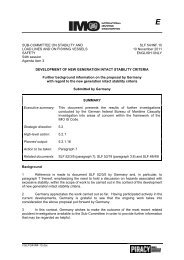Examination of the intact stability and the seakeeping behaviour
Examination of the intact stability and the seakeeping behaviour
Examination of the intact stability and the seakeeping behaviour
You also want an ePaper? Increase the reach of your titles
YUMPU automatically turns print PDFs into web optimized ePapers that Google loves.
2 Theory<br />
2.1 Description <strong>of</strong> <strong>the</strong> utilised <strong>seakeeping</strong> simulation method<br />
For <strong>the</strong> determination <strong>of</strong> <strong>the</strong> <strong>seakeeping</strong> behavior, E4 includes a simulation method developed<br />
by Söding in connection with <strong>the</strong> investigation <strong>of</strong> <strong>the</strong> capsizing accident <strong>of</strong> <strong>the</strong> E.L.M.A Tres<br />
in 1987 [5]. The method has been fur<strong>the</strong>r developed by Kröger [6] <strong>and</strong> in <strong>the</strong> scope <strong>of</strong> several<br />
research projects at <strong>the</strong> TUHH which led to <strong>the</strong> actual <strong>seakeeping</strong> method E4ROLLS. The<br />
following explanations are based on Krüger [7], Kluwe [8] <strong>and</strong> <strong>the</strong> investigation reports <strong>of</strong><br />
<strong>the</strong> three accidents [1][2][3] described in chapter 1.1.<br />
The method is capable <strong>of</strong> simulating <strong>the</strong> motion <strong>of</strong> a ship within <strong>the</strong> time domain. At this all<br />
six degrees <strong>of</strong> freedom <strong>of</strong> a ship are described. Fur<strong>the</strong>r it is possible to enter regular or irregular,<br />
as well as short or long crested seaways. The method is explained briey in <strong>the</strong> following chapter.<br />
2.1.1 Linear strip method<br />
In <strong>the</strong> E4 <strong>seakeeping</strong> method a linear RAO is determined for each <strong>of</strong> <strong>the</strong> six degrees <strong>of</strong> freedom.<br />
The RAOs are calculated by means <strong>of</strong> a strip method in <strong>the</strong> frequency domain. Each set <strong>of</strong> six<br />
RAOs applies for one vessel's speed. Therefore one set <strong>of</strong> RAOs has to be calculated for each<br />
speed examined.<br />
Four <strong>of</strong> <strong>the</strong> degrees <strong>of</strong> freedom, namely sway, heave, pitch <strong>and</strong> yaw are calculated linearly using<br />
<strong>the</strong> respective RAOs. A link to <strong>the</strong> nonlinear motions is considered. It is assumed, that <strong>the</strong><br />
amplitudes <strong>of</strong> <strong>the</strong>se four motions stay moderate <strong>and</strong> that <strong>the</strong> hydrodynamic inuences outweigh<br />
<strong>the</strong> nonlinearities. Therefore it is adequate to incorporate <strong>the</strong>m linearly. Due to <strong>the</strong> linearisation<br />
<strong>of</strong> <strong>the</strong> sway <strong>and</strong> yaw motion, <strong>the</strong> method is not able to describe broaching in following sea, which<br />
<strong>of</strong>ten causes high roll motions <strong>and</strong> implicates an enhanced danger <strong>of</strong> capsizing. For <strong>the</strong> same<br />
reason <strong>the</strong> method overestimates <strong>the</strong> ship's motions in beam seas at low speeds. This is related<br />
to an underestimation <strong>of</strong> <strong>the</strong> drift motion in beam direction.<br />
2.1.1.1 Calculation model<br />
The lightship weight <strong>and</strong> <strong>the</strong> deadweight distribution are represented by a cuboid for each analysed<br />
vessel. The cuboid <strong>and</strong> <strong>the</strong> ship have equivalent mass moments <strong>of</strong> inertia. Its height <strong>and</strong><br />
width shown in gure 2.1 are governed by <strong>the</strong> extension <strong>of</strong> <strong>the</strong> light-ship <strong>and</strong> <strong>the</strong> loading weight.<br />
The cuboid <strong>and</strong> <strong>the</strong> hull form are <strong>the</strong>n used to calculate <strong>the</strong> RAOs.<br />
5

















